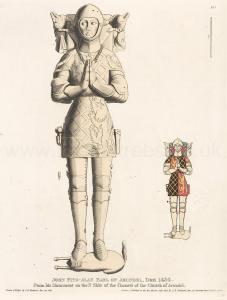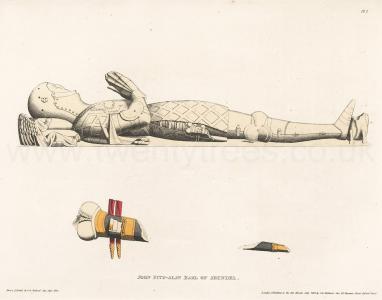Effigy of John Fitz-Alan, Lord Maltravers and Earl of Arundel
Effigy of John Fitz-Alan, Lord Maltravers and Earl of Arundel is in Monumental Effigies of Great Britain.
JOHN FITZ-ALAN was descended directly, in the third degree, from John the second son of Richard Earl of Arundel, noticed at p. 83, who [Note. John.] married Eleanor daughter of Lord Maltravers, he was the eldest son of John Fitz-Alan, Lord Maltravers, by his wife Eleanor (age 54), daughter of Sir John Berkeley, and was born in 1407. His father had previously succeeded to the estates of his kinsman, Thomas Earl of Arundel, grandson of Richard before mentioned, by the elder branch; but it does not appear that he ever bore the title of Earl of Arundel. In 1432 John Fitz-Alan preferred a petition to the Parliament that he might be admitted to his due place in all public councils, inasmuch as he was seised of the Castle and Honour of Arundel, to which the title of Earl had, by peculiar custom, time out of mind, been annexed.

The right to the Honour of Arundel was counterclaimed by John Duke of Norfolk, but it was adjudged to Fitz-Alan; it appearing that Richard Earl of Arundel had by legal process in the reign of Edward the Third entailed it on his male issue. In 1434 he accompanied the expedition of the celebrated John Talbot, afterwards Earl of Shrewsbury, into Normandy, where he distinguished himself by the capture of many towns and fortresses. Charles, the French King, had caused the ancient mouldering castle of Gerbroi to he repaired and fortified, as it commanded the entrance from Normandy into the territory of Beauvais. In the castle was placed a garrison of three thousand men, under the command of the Chevalier Etienne de Vignolles. The Earl of Arundel, ignorant of the formidable state of defence in which the post was thus placed, thought to carry it by a and advanced with five hundred horse to the neighbourhood of Gerbroi, encamping in a little meadow before the castle. His archers on foot were yet some distance in the rear. The wily enemy were aware of this circumstance, and made a sally, at hrst with fifty horsemen only, in order to induce the Earl to believe their numbers were insignificant. To them the Earl opposed one hundred of his cavalry, under Sir Ralph Standish, when suddenly the whole remaining force of the enemy poured out from under cover of the fortifications to sustain their companions. The English, true to their intrepid nature, nobly bore up against such overwhelming odds. Standish was slain. Fitz-Alan hastened to the scene of action. Vignolles perceiving, from the valour of the little band of English, that the fight was still doubtful, opened a fire on them from three culverins. These "mortal engines," which, as the hero of Cervantes remarks, render the skill of personal arms of little avail, decided the contest; such devilish instruments, he says, "put it in the power of a cowardly and base hand to take away the life of the bravest cavalier; to which it is owing that, not knowing how or from whence, in the midst of that resolution and bravery which animates gallant spirits, comes a chance ball, shot oH perhaps, by one who Red and was frightened at the very dash of the powder, and in an instant cuts short and puts an end to the thoughts and life of him who deserved to have lived for many agesa." Fitz-Alan's leg was broken by a shot, which struck him off his horse. He lay helpless on the ground, an easy capture for the enemy. Two hundred of his men were killed; sixty were made prisoners with himself. He was carried to Beauvais, where he died of his wound, on the 12th May, 1434, and was buried in the monastery of the Grey Friars at that place. By his last will, made some time previous to his death, he had directed that he should be buried in the collegiate church of Arundel, founded by his ancestors. With that intention the tomb there remaining was probably in his lifetime prepared.
Note a. Don Quixote, vol. 1. chap, xxxvii.
The effigy of this Earl of Arundel wears the collar of SS. or, as we may pretty confidently term it, Soverayne. The surcoat, or tabard, has short sleeves. The camail, it will be observed, has now disappeared as a defence for the neck, and is replaced by a gorget of plate-armour.
Details. Plate 1. Figure as originally painted. On the surcoat, Arundel quartering Maltravers.

